Popular lakes in Nepal
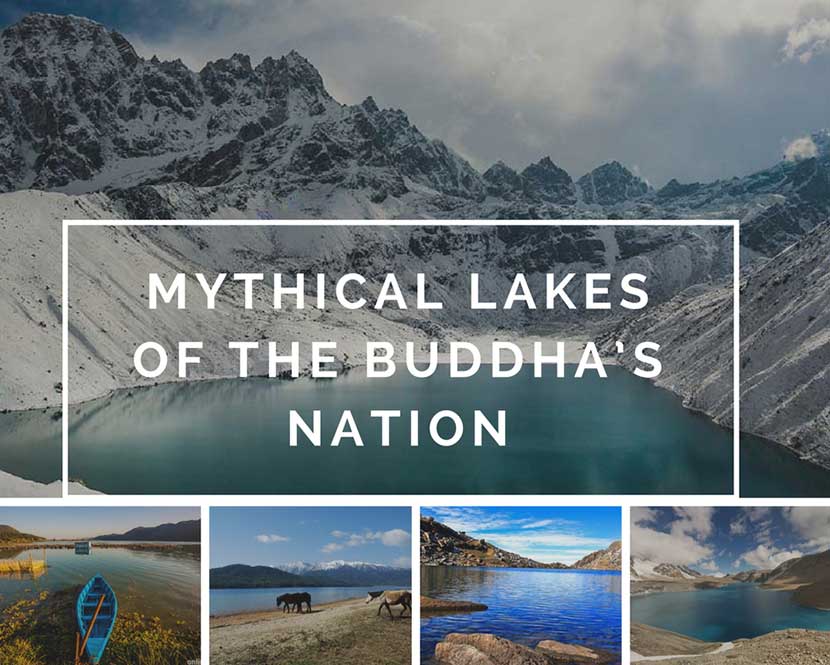
- 30-Apr-2018
- 0
Nepal, renowned as the birthplace of Gautam Buddha: The light of Asia; is a small land lock sovereign Himalayan state in South Asia. The nation flaunts eight of the ten highest peaks in the world with the Mt. Everest being the highest peak on the planet, also bears the name Sagarmatha in Nepali. It showcases astounding diverse topography resulting in the possession of lush greenery and boscage. Therefore, the country harbours myriad species of flora and fauna.
Nepal is the second richest country in fresh water-resources; all thanks to alluring turquoise Himalayan water slipping away on craggy abyss due to glacial flow and the melting of the snow of the mountain peaks. This moulds the nation into a miraculous landing-place overflowing with features of a marvellous trek for tourists and travellers. Trekking in Nepal is one of the celebrated and recommended adventure activities among visitors to enact. Nepal takes prides on its scenic lakes that can stop anyone’s breathe for a moment at its first look. The highlights are glacier lakes present a heavenly reflection of the surrounding mountains on their surface. Graceful appearances aside, the lakes bear religious and traditional importance; receiving visitors and pilgrims from all over the world. These elegant lakes adorn and enhance the splendour of landscapes; therefore, it is considered as the country’s gems.
The republic is blessed with 5,358 lakes where 2,227 lakes (42%) lie above 3,000m (Bhuju et al., 2009). The lakes are a natural heritage for the land of Gorkhalis that generously contribute to the region they are located in. Here are some pre-eminent and significant lakes in the Buddha’s nation.
Rara Lake:
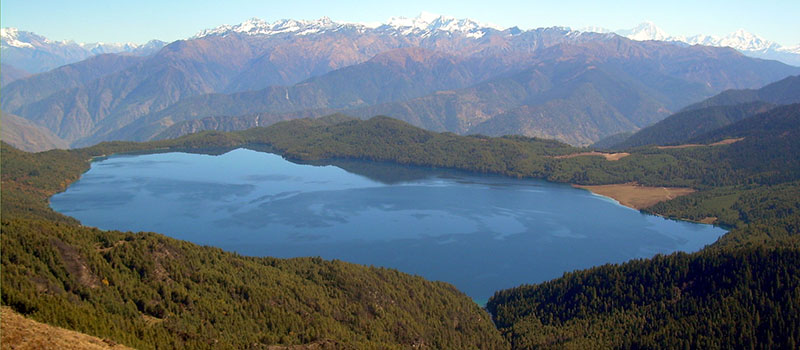
Referred as The “queen of lakes”, “a shimmering blue jewel ring set amidst surrounding white peaks” by numerous visitors at its first glance; Rara lake is the biggest and deepest natural lake that steals the spotlight in the Rara National Park, located in the Jumla and Mugu Districts of Nepal. Located at the elevation of 2,990m above sea level featuring, a maximum depth of 167m is 5.1 km long and 2.7 km wide with a water surface of 10.8 km2. It has only one outlet that joins the river Karnali. Rara is a heavenly lake with its prepossessing environment with the residence of exclusive flora and fauna including rare and vulnerable species. In 2007, Rara was declared a Ramsar site. It is renowned for trekking expeditions where the sight of terrace-farms and terrains lush with the growth of vegetation can be admired en route. With the reflection of the shadows of Sisne and Kanjirowa mountains on its waters, the divine beauty of Rara is unleashed; simply befitting the praises it is referred to.
Tilicho Lake in Annapurna Region

Tilicho Lake is a delightful glacier lake beaming with turquoise hues, based on Manang district of Gandaki zone in Nepal. Being the lake for its size situated at the highest altitude in the world, Tilicho Lake stands at an elevation of 4919m above the sea level. Lying just 55km away from Pokhara, Tilicho is the celebrated hotspot in the famous Annapurna Circuit Trek. The lake harbours no life within its waters and stays frozen over during winters. In early 2000, the lake was once the site of one of the highest ever altitude scuba dives. Generally, Tourists prefer to arrive at Tilicho after passing through the mighty Thorung La Pass at the altitude of 5416m, as the parent range of the lake is the Annapurna Massif. Snow-capped peaks of Nilgiri, Tilicho, Khangsar and Muktinath surround and adorn the lake inflating its charm and beauty.
Gokyo Lakes in Everest Region
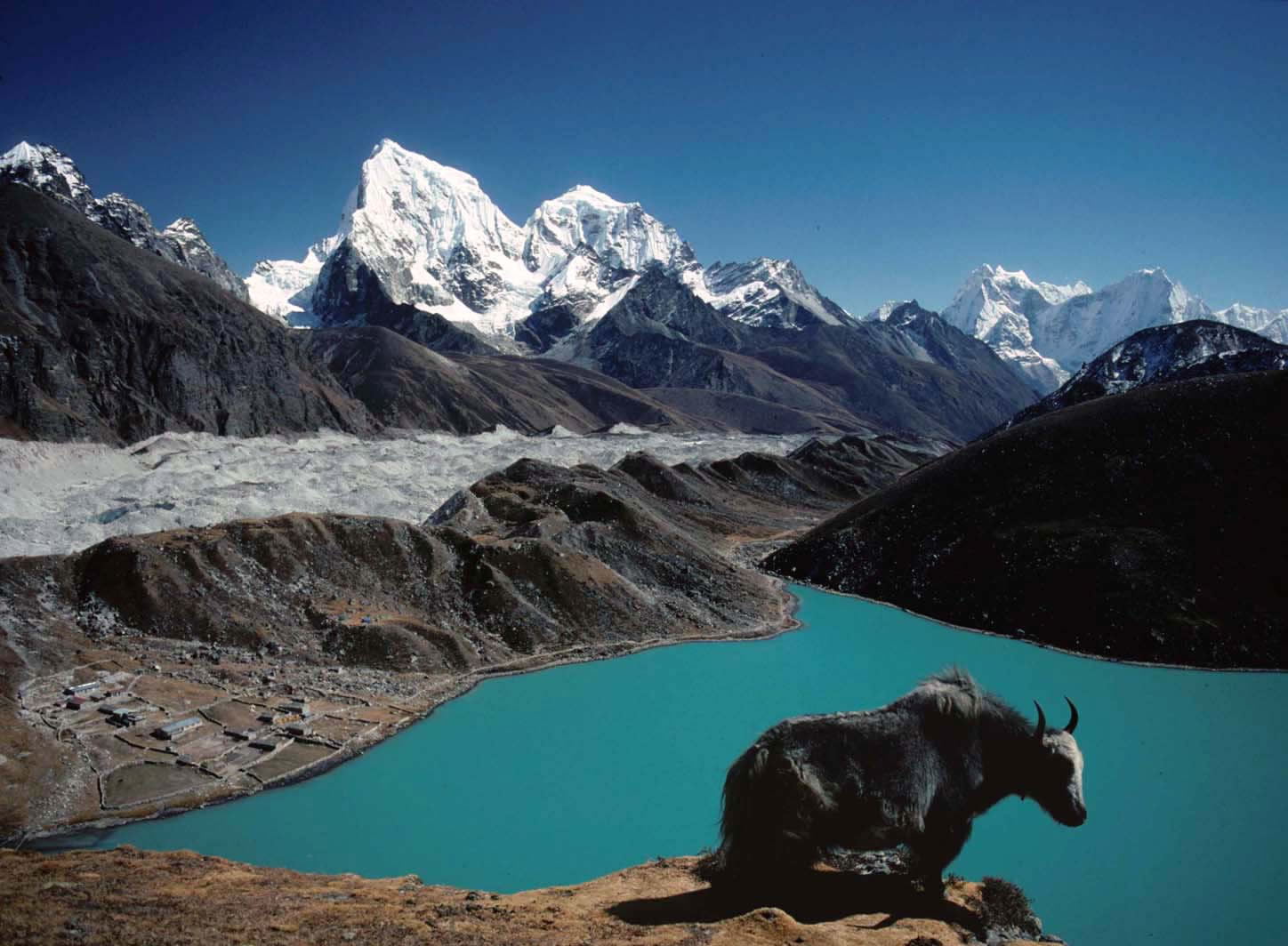
Positioned at Sagarmatha National Park at high elevation further than 4,790m above sea-level, the ravishing Sapphire Oligotrophic lakes of Gokyo are highest freshwater lake systems, comprised of six main lakes where Gokyo Lake is the most popular. The Gokyo Lakes is also declared as Ramsar site and the trekkers never miss to visit this most outstanding feature of Everest Gokyo Lake Trek in the Everest Region. The lakes are fed by fresh water that seeps from Ngozumpa glacier and a stream flowing from and through the Renjo-La Pass. Gokyo Lakes are naturally in peril as it is situated in ecologically delicate and wobbly zone. Starting from the entrance, the exploration of the region leads to spot Longpongo Lake first; trailed by the Toboche Tsho and then, Gokyo Cho (Dudh Pokhari). The lakes are fed by various sources, like the Ngozumpa glacier and a stream coming through from the Renjo-La Pass and drain into the Dudh Koshi Headway. Gokyo Lakes: a sacred shrine to both Hindu and Buddhist, devotees consider the water of the lake to be holy and bath in it during the Janai Purnima and Gangadashara festivals. The region in/around the lake conserves various flora and fauna via religious assurance and presents the jaw-dropping vista of Gokyo Ri.
Shey Phoksundo Lake in Dolpa Region

Shey Phoksundo Lake is also officially entitled as Ramsar Site. It is a sapphire-hued, freshwater lake in the Shey Phoksundo National Park, located at Dolpa district of Nepal. Situated at the elevation of 3611m above sea level, it is a well-renowned destination of Upper Dolpo Trek and Lower Dolpo Trek that highlights rich cultural diversities, gorgeous terrains, and outlook of mountain peaks. The village of Ringmo lies on the southern side of the Phoksundo that is established on approx. forty century aged landslide dam that shaped the very lake. Buddhism and Bon religions are dominant in lower Dolpo; whereas, classical Tibetan culture influences the residents of upper Dolpo comprehending the natives of Ringmo village. There are 20 or more stupas in the southern region of the lake; meanwhile, annual prayers and worship are carried out in the Gompa situated in the eastern region of the lake.
Gosaikunda Lake in Langtang Region
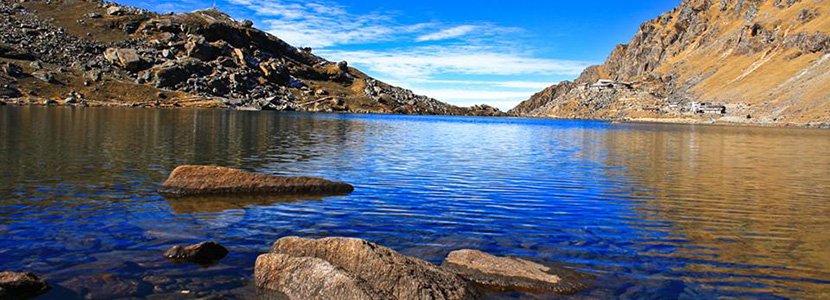
An alpine freshwater oligotrophic lake in Nepal’s Langtang National Park, Gosaikunda is situated at the elevation of 4,380m in the southernmost point of Tibet near the Nepal–Tibet border in the Rasuwa District of Nepal and a must visit destination of the prominent Langtang Valley Trek. The Lake remains frozen half of the year; for remaining time frame the lake melts and sips down to form the Trishuli River. On 29 September 2007, with 108 neighbouring lakes varying in small to medium sizes, the Gosaikunda Lake complex with the area of 4.0 mi2 has been designated as Ramsar site. The lake is sacred sites for Hindu and Buddhist religions as it is proclaimed as Lake of Lord Shiva. Gosaikunda Lake is the enchantress as many ancient legends surround the lake. Like, Gosainkunda is believed to have been erected by Lord Shiva to extract the water from a mountain via thrusting his holy Trident so that he could cool his stinging throat after swallowing a deadly poison that was threatening to destroy the planet. Similarly, it is also believed that a “married couple” should not go to the lake together. Likewise, Hindu mythology accredits Gosainkunda as the abode of the legendary Hindu deities Shiva and Gauri. In Newari culture, a 5-day trek to Mansarovar (Gosainkunda) recognized as “Silu”, is performed for a single dive in the lake’s waters to wash out all sins. The waters of the lake are considered holy and of distinct importance during Gangadashahara and the Janai Purnima festivals when numerous devotees from Nepal and India visit the region. A short trek of about an hour from Gosaikunda will lead to Suryakunda, Aama Kunda and other small lakes with breathtaking vistas of Ganesh Himal and Langtang Lirung. Then, the trail extends from there to Helambu region.
Phewa Tal, Begnas Tal and Rupa Tal in Pokhara
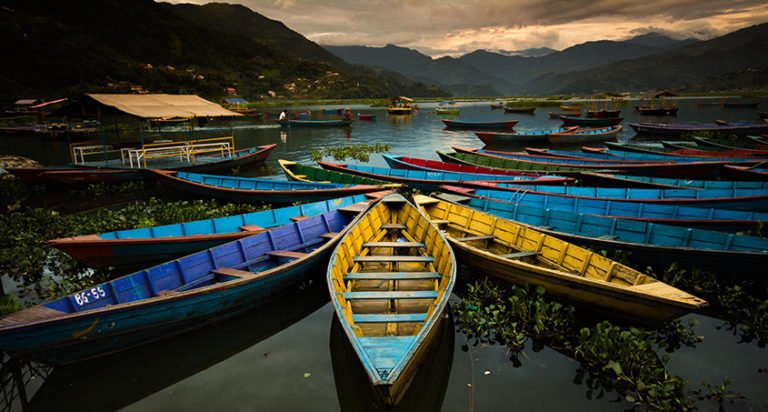
Fewa Lake is the second-largest freshwater lake in Nepal positioned south of the Pokhara valley. Located at an elevation of 7,42m with the Annapurna Mountain Range lying only about 28 km further; it is the pre-eminent feature of Pokhara city. With the marvellous reflection of the Machhapuchhre Himal cast on its surface, Fewa Lake is renowned for recreational boating by tourists while featuring the Taal Barahi temple based on an island in the lake. As a tourist hotspot of the Pokhara city, a northern shore of Fewa Lake has been developed into a tourist region, often known as the Lake-side, harbouring hotels, restaurants and bars catering for visitors.
The unheeded Begnas: the third largest lake in Nepal and Rupa: the third largest lake in Pokhara Valley of Nepal, lie at a short distance to the east of Pokhara Valley; just off the main highway. The whole environment is nearly untouched and more authentic form of the lake in “The lake city” can be observed in the uncrowded atmosphere. The spell-binding Annapurna massif generates a colossal and majestic backdrop to the splendid vistas at Begnas and Rupa lakes. Both lakes provide enough space for boating experiences for the visitors. Also, these lakes support Cage culture as well as pen culture practices for fish farming.
Paanch Pokhari in Langtang Region
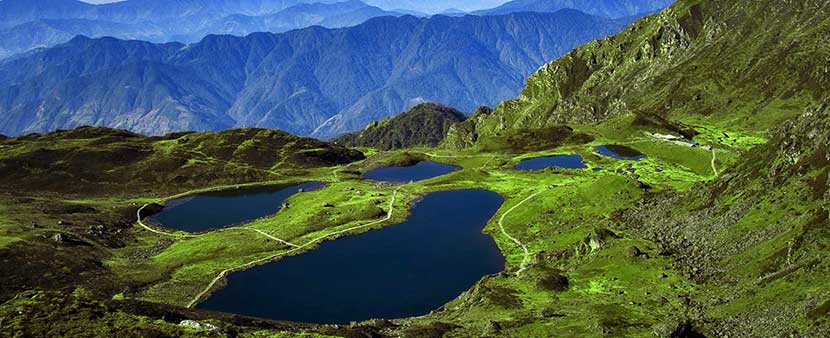
Being geographically landlocked; therefore, untouched by urbanization, the magnificent Paanch Pokhari situated at an elevation of 4,100m in the north-east region of Nuwakot, Rasuwa and Sindhupalchowk districts of Nepal. Comprising of five lakes; the region is one of the main features of Langtang National Park and Paach Pokhari Trek; it is surrounded by various mountains i.e. Langtang Himalayan Range, Jugal Himalayan Range, Mt. Dorje Lakpa, Mt. Phurbu Chachu, Mt. Madiya etc. Despite being close to Kathmandu, it is a remote and unheeded region bearing significant religious importance. Janai Purnima: An important festival for Hindus that held every year in August; Brahmin castes come here to perform the ritual that allows them to change the sacred thread (Janai) they wear around their bodies. The Panch Pokhari region is recognized worldwide as the ninth high wetland of the planet and showcases alluring outlook comprising of sapphire-hued lakes blended with amazing mountain scenery.
Khaptad Lake
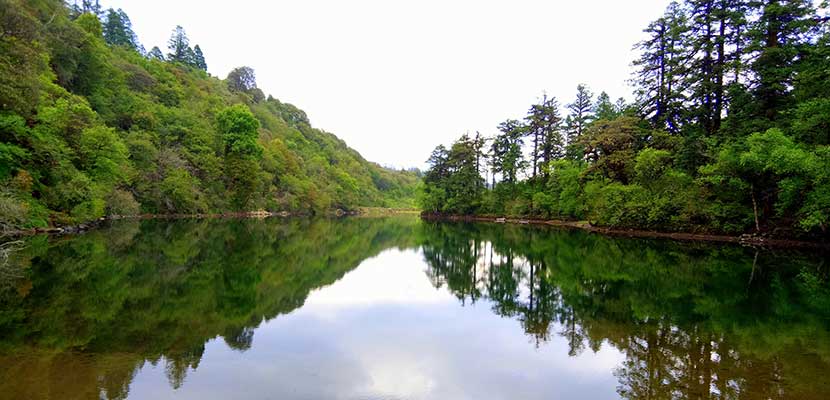
Khaptad Daha/Lake, a lake that lies at an elevation of 3,050m above the sea level in the far western region of Nepal, on the northeastern part of the Khaptad National Park. Because of its remoteness the region has been kept untarnished by the large volume of visitors. The alluring shallow lake is surrounded by dense woodland and carries the religious importance and is believed washed away the sins if take a dip is taken here.
Taudaha and Nagdaha in Kathmandu Valley
Based on the Kritipur District in the Kathmandu Valley, Taudaha is potentially one of the few clean water body present in the Kathmandu Valley today. The name ‘Taudaha’ originates with the blend of two Newari words: ‘Ta' and 'Daha', translates to snake and lake respectively. Taudaha is the sojourn for diverse species of migratory bird like cormorant, ruddy shelduck, serpent eagle and common teal; therefore, considered as the important site for Bird watching. Legends surrounding the lake suggest that Taudaha is one of the lakes that were formed when the ancient lake of Kathmandu Valley was drained away. Due to the drainage of the lake numerous nagas; mythological creatures that were half human and half serpent were left homeless. This made Naga king Karkotak angry. To mollify his anger, locals built an underwater palace that pleased the serpent king; thus, establishing the lake as a resident of Nagas. It is still believed that the Naga king resides in Taudaha until today.
Nagdaha is situated in the Lalitpur District in the Kathmandu Valley. Like Taudaha, it is also wrapped in legends. One of them suggests that a female serpent resides in Nagdaha. Extensively described in ancient scriptures and oral history of Kathmandu as a serpent king, the male serpent set off to participate in a festival that occurs in the town of Panauti during the rainy season. Followed by heavy rain, it is believed that the male serpent unites with the female serpent of Nagdaha on his way to and back from Panauti. Legends aside, Nagdaha is a gorgeous freshwater lake and renders peaceful atmosphere to its visitors.
These mythical lakes of the birthplace of Gautam Buddha bear the multi-cultural importance showcasing an exemplary cultural tolerance and harmony among the residents of the country; moulding the nation into an appropriate place to learn and obtain the first-hand experience regarding the different traditions and the delicate balance between them. Therefore, a visit to this Himalayan nation seems to be befitting if you want to take your family and loved ones for a spell-binding natural and cultural experience. So, if you want to come to Nepal and visit the above-mentioned places, you can contact us; we’ll help you to organize your trip to these locations with the professional methodology and guidance.




